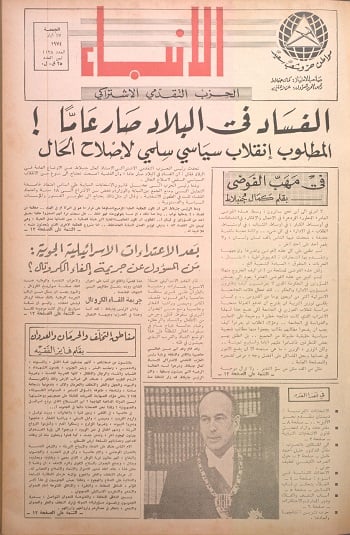Once Upon A Revolution: An Egyptian Story
4 يوليو 2015

By Thanassis Cambanis
Reviewed by John Waterbury
Cambanis’ remarkable account of Egypt’s 2011 uprising and 2013 counterrevolution is built on his firsthand reporting. Cambanis was in the country during both developments and shared in the initial euphoria and in the bitter disappointment that followed. He tells the story mainly through in-depth profiles of two men: Basem, a middle-aged, secularist architect who became politically active in anger at the almost comically fraudulent 2010 parliamentary elections that confirmed President Hosni Mubarak’s grip on power, and Moaz, a young activist in the Muslim Brotherhood, impatient with the group’s leadership and willing to cooperate with people like Basem.
Cambanis’ analysis is sharp, and he does not hold back when it comes to graphically depicting the Egyptian state’s violence against its own people, be they Coptic Christians or Muslim Brotherhood supporters. In his gripping account of the 2011 massacre of some two dozen Copts at a protest in front of the Maspero television building in Cairo, Cambanis squarely blames the violence on the military leadership.
Likewise, Cambanis accuses the military of deliberately killing as many Brotherhood supporters as possible during a protest against the 2013 military coup that brought General Abdel Fattah el-Sisi to power. Cambanis claims, at one point, that the lessons of the 2011 uprising cannot be unlearned. But even though the Egyptian people pushed out one autocrat, Sisi’s regime is more authoritarian and less liberal than Mubarak’s. So it’s not altogether clear what the lessons are.
—————————————
Source: Foreign Affairs Magazine
 عن أمل جنبلاط المتجدد: لبنان يستحق النضال
عن أمل جنبلاط المتجدد: لبنان يستحق النضال
 صحافيون أم عرّافون!
صحافيون أم عرّافون!
 ماذا يجري داخل أروقة بيت الكتائب المركزي؟
ماذا يجري داخل أروقة بيت الكتائب المركزي؟


 عن الخرائط التي تُرسم والإتفاقات التي تتساقط!
عن الخرائط التي تُرسم والإتفاقات التي تتساقط!
 “الإنحراف في الحياة”/ بقلم كمال جنبلاط
“الإنحراف في الحياة”/ بقلم كمال جنبلاط
 هاشتاغ #صار_الوقت يحل أولاً في حلقة جنبلاط
هاشتاغ #صار_الوقت يحل أولاً في حلقة جنبلاط
 طاولة نقاش عن أزمة الصحافة في جامعة AUST
طاولة نقاش عن أزمة الصحافة في جامعة AUST
 عبدالله: ليظهر لنا وزير مكافحة الفساد حرصه في صفقات البواخر والفيول
عبدالله: ليظهر لنا وزير مكافحة الفساد حرصه في صفقات البواخر والفيول
 عبدالله: غريب أمر وزارة مكافحة الفساد!
عبدالله: غريب أمر وزارة مكافحة الفساد!

 Comment to Uri Avnery: How Sad What Is Looming Ahead
Comment to Uri Avnery: How Sad What Is Looming Ahead
 “Not Enough!”
“Not Enough!”
 … لمن لم يقرأ يوسف البعيني/ بقلم وسام شيّا
… لمن لم يقرأ يوسف البعيني/ بقلم وسام شيّا
 كمال جنبلاط في مولده الأول بعد المائة: تعاليمه وأفكاره ما زالت الحلّ/بقلم عزيز المتني
كمال جنبلاط في مولده الأول بعد المائة: تعاليمه وأفكاره ما زالت الحلّ/بقلم عزيز المتني
 رئيس حزب/ وليس (… سابقاً)/ بقلم د. خليل احمد خليل
رئيس حزب/ وليس (… سابقاً)/ بقلم د. خليل احمد خليل
 التوازن السياسي في لبنان
التوازن السياسي في لبنان
 لبنان… مشاريع انقلابية مؤجلة
لبنان… مشاريع انقلابية مؤجلة
 جنبلاط وحَمَلة أختام الكاوتشوك
جنبلاط وحَمَلة أختام الكاوتشوك
 Le Liban est un symbole de tolérance
Le Liban est un symbole de tolérance
 Our Automated Future
Our Automated Future
 The True Origins of ISIS
The True Origins of ISIS
 Les Misérables vs. Macron
Les Misérables vs. Macron
 عذراً أيها المعلم/ بقلم مهج شعبان
عذراً أيها المعلم/ بقلم مهج شعبان
 رساله الى المعلم / بقلم ابو عاصم
رساله الى المعلم / بقلم ابو عاصم
 إلى روح القائد والمعلم كمال جنبلاط/ بقلم أنور الدبيسي
إلى روح القائد والمعلم كمال جنبلاط/ بقلم أنور الدبيسي
 أسرار وعناوين الصحف ليوم الجمعة 14 كانون الاول 2018
أسرار وعناوين الصحف ليوم الجمعة 14 كانون الاول 2018














